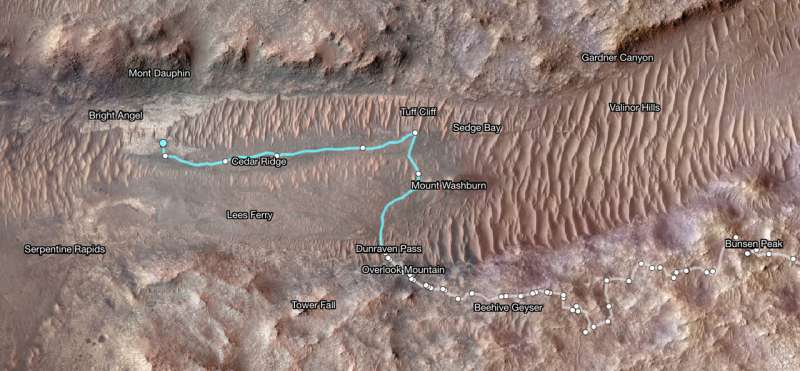
Superimposed on an image from NASA’s Mars Odyssey orbiter, this map shows Perseverance’s path between January 21 and June 11. The white dots indicate where the rover stopped after making a crossing along the Neretva Vallis river channel. The pale blue line indicates the rover’s route inside the canal. Credit: NASA/JPL-Caltech/University of Arizona
Originally envisioned as simply a route clear of rocks slowing the rovers, Neretva Vallis provided a wealth of geological options for the science team.
After detouring through a dune field to avoid rocks that slammed its wheels, NASA’s Perseverance Mars rover reached its final area of scientific interest on June 9. The change in route not only reduced the estimated travel time to reach this area, nicknamed “Bright Angel”, to several weeks, but also gave the scientific team the opportunity to discover interesting geological features in an ancient river channel.
Perseverance is in the final stages of its fourth scientific campaign, searching for evidence of carbonate and olivine deposits in the “Margin Unit”, an area located inside the rim of Jezero Crater. Located at the base of the canal’s north wall, Bright Angel features light-toned rock outcrops that may represent either ancient rocks exposed by river erosion or sediments that filled the canal. The team hopes to find rocks different from those in the carbonate- and olivine-rich margin unit and gather more clues about Jezero’s history.
To get to Bright Angel, the rover drove over a ridge along the channel of the Neretva Vallis River, which billions of years ago carried a large amount of water flowing into Jezero Crater. “We started following the channel in late January and made good progress, but then the rocks got bigger and more numerous,” said Evan Graser, deputy manager of Perseverance’s strategic route planner at the Jet Propulsion Laboratory in NASA in Southern California. “What averaged more than a hundred meters per Martian day dropped to only a few dozen meters. It was frustrating.”

Assembled from 18 images taken by NASA’s Perseverance rover, this mosaic shows a field of rocks on “Mount Washburn” on May 27. Intrigued by the diverse textures and chemical composition of the light-colored rock at the center, the rover’s science team dubbed the rock “Atoko Point.” Credit: NASA/JPL-Caltech/ASU/MSSS
The zapping
In rough terrain, Evan and his team use the rover’s imagery to plan paths of about 100 feet (30 meters) at a time. To go further on a given day or Martian soil, planners rely on Perseverance’s automatic navigation system, or AutoNav, to take over.
But as the rocks became more numerous, AutoNav would, most of the time, determine that the situation was not to its liking and shut down, thus dimming the prospects of a quick arrival at Bright Angel. The team remained hopeful, however, knowing they could successfully cross a quarter-mile (400-meter) dune field in the river channel.
“We looked at the river channel just to the north, hoping to find a section where the dunes were small and far enough apart that a rover could pass between them, because dunes are known to devour Mars rovers,” Graser said. . “Perseverance also needed an entrance ramp that we could safely descend on. When the images showed both, we headed toward it.”
The Perseverance science team was also eager to travel the ancient river channel because they wanted to study ancient Martian river processes.

NASA’s Perseverance rover was traveling in the ancient channel of the Neretva Vallis River when it captured this view of an area of scientific interest named “Bright Angel” – the bright area in the distance to the right – with one of its navigation cameras on June 6. Credit: NASA/JPL-Caltech
Rock star
With AutoNav helping to guide the path on the canal floor, Perseverance traveled the 656 feet (200 meters) to the first science stop in one sol. The target: “Mount Washburn,” a hill covered in intriguing rocks, some of a type never before observed on Mars.
“The diversity of textures and compositions of Mount Washburn was an exciting discovery for the team, because these rocks represent a bag of geological goodies descended from the crater rim and potentially beyond,” said Brad Garczynski of the University Western Washington at Bellingham, Bellingham University. co-responsible for the current scientific campaign. “But among all these different rocks, there was one that really caught our attention.” They nicknamed it “Atoko Point”.
About 18 inches (45 centimeters) wide and 14 inches (35 centimeters) high, the light-toned speckled rock stands out against a field of darker rocks. Analysis by Perseverance’s SuperCam and Mastcam-Z instruments indicates that the rock is composed of pyroxene and feldspar minerals. In terms of the size, shape and arrangement of its mineral grains and crystals – and potentially its chemical composition – Atoko Point is in a league of its own.
Some Perseverance scientists believe that the minerals that make up Atoko Point were produced in an underground magma body that may now be exposed on the crater rim. Other team members wonder if the rock was created far beyond the walls of Jezero and transported there by the swift waters of Mars eons ago. Either way, the team believes that while Atoko is the first of its kind they’ve seen, it won’t be the last.
After leaving Mount Washburn, the rover headed north 433 feet (132 meters) to study the geology of “Tuff Cliff” before making the four-sol, 1,985-foot (605-meter) journey up ‘to Bright Angel. Perseverance is currently analyzing a rock outcrop to assess whether a rock core should be taken.
Quote: NASA’s Perseverance fords an ancient river to reach its science goal (June 13, 2024) retrieved June 13, 2024 from https://phys.org/news/2024-06-nasa-perseverance-fords-ancien-river .html
This document is subject to copyright. Except for fair use for private study or research purposes, no part may be reproduced without written permission. The content is provided for information only.